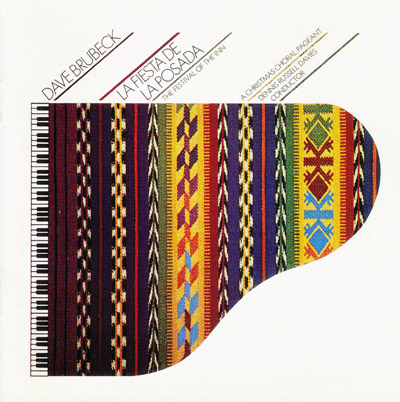
.jpg)

La Fiesta de la Posada

Label: Columbia
Year: 1979
Released on LP: Yes
Released on CD: Yes
Tracks
1. Prelude
2.La Posada
3.Processional
4.In the Beginning
5.Where Is He?
6.Gloria
7.We Have Come to See the Son of God
8.Behold! The Holy One
9.Run, Run, Run
10.Gold, Frankincense & Myrrh
11.My Soul Magnifies the Lord
12.Sleep, Holy Infant, Sleep
13.In the Beginning
14.Neither Death nor Life
15.God's Love (Made Visible)
16.La Piñata
Personnel
Dave Brubeck (piano)Richard Lewis (bass)
Mel Lewis (drums)
Lee Arellano (percussion,vocals)
Phyllis Bryn-Julson (Soprano)
Gene Tucker (tenor)
Jake Gardner (baritone)
John Stephens (bass)
The Dale Warland Singers (chorus)
Edith Norberg’s Carillon Choristers (chorus)
The St. Paul Chamber Orchestra (orchestra)
Dennis Russell Davies (conductor)
Notes
1. A Christmas Choral Pageant ; music by Dave Brubeck and text by Iola Brubeck.
2. Recorded at Orpheum Theater, Minneapolis, Minnesota on 9th May 1979.
3. The LP release by CBS Mastersound was an audiophile pressing.
4. Liner Notes
The posada, a custom depicting Joseph and Mary’s search for lodging on the eve of her confinement, is re-enacted from December 16 to Christmas Eve throughout Latin America and in our own Southwest. Religious and secular traditions, never far apart in the lives of most Mexican villages, are at Christmas indefinably joined.
Details of las posadas may vary from region to region, but certain essentials remain wherever the custom is observed. Children, always an important part of the festivities, join with adults to form a torch and lantern procession and the streets become as crowded and bustling as ancient Bethlehem’s at census time. Joseph leads a donkey, bearing a young girl dressed as The Virgin, or perhaps the children carry a litter of pine boughs which holds decorated clay figures of the Holy Family.
As the procession of villagers winds through the streets singing litanies, they knock at various doors along the route. Each time they are turned away with the cruel words, “There is no room,” until the procession arrives at the appointed home or church. Then, the doors are flung wide in the open spirit of Christmas and the celebration, with Mary as its central figure, beings. Guests kneel before el nacimiento (or, crèche), candles are lit, and the Christmas story is retold in song, dance, music and mime and The Christ Child is welcomed to earth. The unvarying finale of the celebration is the introduction of the piñata, a colorful, symbolically decorated figure of papier maché. The piñata is suspended above the heads of the children. Blindfolded and armed with long poles, youngsters vie for the honor of breaking the piñata and showering the contents of sweets and tiny gifts among all assembled.
I was born in a California town founded by the Spanish, raised on a cattle ranch that had been a Mexican land grant, and have absorbed and observed Mexican folk music all my life. As a musician, I have toured Mexico six times and always enjoyed listening to the folk music of the various regions. The ethnic music reflects those qualities I most admire in people… dignity in moments of tragedy, infectious high spirits in moments of joy, and an unshakeable religious faith made evident in a strong sense of one’s own worth and a deep respect for the shared values of one’s own group — family, church, village. These qualities, I think, are universal to people with a strong communal sense — an increasingly rare attribute in urban culture. It is this sense of sharing in an event which I have tried to capture in the simple retelling of the Christmas story.
Dave Brubeck
Reviews
All Music Guide – Review – copyright
This is a problematic release, for it is a so-so realization of a wonderful piece of music, Brubeck's most frequently performed choral concert work. An evocation of a Mexican Christmas festival, the piece works for several reasons -- a tight structural game plan, marvelous tunes injected with Mexican folk material, catchy off-kilter rhythms and a youthful naive exuberance that masks the rigors of counterpoint and all the other technical stuff that went into its writing. The problem here is that the performance on this CD is rather flat; reported non-musical tensions at the recording session were supposedly responsible.
Conductor Dennis Russell Davies hurries through the piece with the St. Paul Chamber Orchestra and Dale Warland Singers, and even Brubeck, in three brief appearances with his trio, seems to go through the motions. Moreover, this was one of the earliest experimental digital productions -- issued on an audiophile LP in its time -- and the sound is wiry and dim, mastered at a very low level on the CD (you really have to crank up the volume). La Fiesta can really shine -- Brubeck's exultant live performances of the work prove that -- yet this recording only conveys the outlines of a terrifically uplifting experience. Alas, this is the only recording we have, so buy it and pray that Telarc or someone else records a new one someday.
Richard S Ginell
© Copyright Rovi Corporation